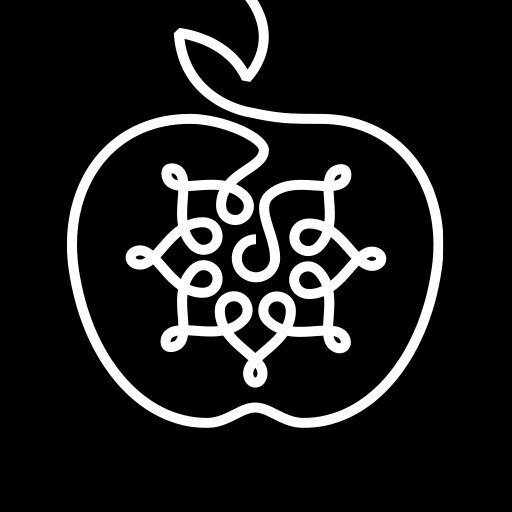The tale «Zukhra» and an apple tree as the symbol of Almetyevsk
Folklore and history remaking
Hitnes (Rome, Italy)
15 the 8th of March Street
90 Herzen Street
90 Herzen Street
History of Apples. Diptych
Алмалар тарихы. Диптих
Context
An artistic interpretation of apple trees, one of the symbols of Almetyevsk.

In the 1950s, when the present-day town was a village called Almetyevo, there were found oil fields. After this discovery a number of inhabitants started to grow rapidly. In 1952 the village got a status of a worker's settlement, and in a year it was granted a town status. There were built new residential districts, educational and cultural institutions. Local residents shared their memories during a folklore expedition. They told that once a great number of trees were planted in the town, including apple trees. It was done due to the town greening program. Shortly afterwards people started to take away some tree sprouts in order to plant their garden plots with apple trees. Newly built Almetyevsk was sinking in an apple blossom, and swallows were flying over the bloom. Residents associated their cries with the phrase «Allah-Allah». The semantic link with the trees has been kept in the name of the town: the Tatar word «Alma» is related to apples.

Almetyevsk, 1986.
In the 1950s, when the present-day town was a village called Almetyevo, there were found oil fields. After this discovery a number of inhabitants started to grow rapidly. In 1952 the village got a status of a worker's settlement, and in a year it was granted a town status. There were built new residential districts, educational and cultural institutions. Local residents shared their memories during a folklore expedition. They told that once a great number of trees were planted in the town, including apple trees. It was done due to the town greening program. Shortly afterwards people started to take away some tree sprouts in order to plant their garden plots with apple trees. Newly built Almetyevsk was sinking in an apple blossom, and swallows were flying over the bloom. Residents associated their cries with the phrase «Allah-Allah». The semantic link with the trees has been kept in the name of the town: the Tatar word «Alma» is related to apples.


Almetyevsk, 1986.
«There is no one here, it is empty. After a while she shouted again, then again and again, but Black Snake is not here. Zukhra was discouraged. Dead silence. There was a black fog over the lake. Accidentally she watched her steps and saw his head on the ground. She screamed in a terrible voice and wept bitter tears, cuddling the head. Zukhra realised how everything had happened. She realised how her mother had betrayed her then. Zukhra stood up, found the body of Black Snake and together with her children she dug a pit. They buried a padishah of jinns and were flooding in tears. Then Zukhra, crying and moaning, took one of her children and dropped him right in the sky.
– Go my dear, turn into a nightingale and calm people with your lovely song.
Then her child turned into a nightingale and went away. Zukhra took a second of them:
– You, the apple of my eye, be a swallow, let the people admire your agility.
As the child was turned into a swallow, he flew away. She took her third child and was looking at him, weeping.
– And you, my darling, turn into a wise starling, who knows all languages of the world.
And the starling went away. Then Zukhra roused herself once, then twice and became a grey dove.
This is how nightingales, swallows, starlings and gray-winged doves might have appeared in the world.»
A fragment from a tale «Zukhra» from a storybook «Tatar folk tales», Tatar book publisher, Kazan, 1986.
– Go my dear, turn into a nightingale and calm people with your lovely song.
Then her child turned into a nightingale and went away. Zukhra took a second of them:
– You, the apple of my eye, be a swallow, let the people admire your agility.
As the child was turned into a swallow, he flew away. She took her third child and was looking at him, weeping.
– And you, my darling, turn into a wise starling, who knows all languages of the world.
And the starling went away. Then Zukhra roused herself once, then twice and became a grey dove.
This is how nightingales, swallows, starlings and gray-winged doves might have appeared in the world.»
A fragment from a tale «Zukhra» from a storybook «Tatar folk tales», Tatar book publisher, Kazan, 1986.
«There is no one here, it is empty. After a while she shouted again, then again and again, but Black Snake is not here. Zukhra was discouraged. Dead silence. There was a black fog over the lake. Accidentally she watched her steps and saw his head on the ground. She screamed in a terrible voice and wept bitter tears, cuddling the head. Zukhra realised how everything had happened. She realised how her mother had betrayed her then. Zukhra stood up, found the body of Black Snake and together with her children she dug a pit. They buried a padishah of jinns and were flooding in tears. Then Zukhra, crying and moaning, took one of her children and dropped him right in the sky.
– Go my dear, turn into a nightingale and calm people with your lovely song.
Then her child turned into a nightingale and went away. Zukhra took a second of them:
– You, the apple of my eye, be a swallow, let the people admire your agility.
As the child was turned into a swallow, he flew away. She took her third child and was looking at him, weeping.
– And you, my darling, turn into a wise starling, who knows all languages of the world.
And the starling went away. Then Zukhra roused herself once, then twice and became a grey dove.
This is how nightingales, swallows, starlings and gray-winged doves might have appeared in the world.»
A fragment from a tale «Zukhra» from a storybook «Tatar folk tales», Tatar book publisher, Kazan, 1986.
– Go my dear, turn into a nightingale and calm people with your lovely song.
Then her child turned into a nightingale and went away. Zukhra took a second of them:
– You, the apple of my eye, be a swallow, let the people admire your agility.
As the child was turned into a swallow, he flew away. She took her third child and was looking at him, weeping.
– And you, my darling, turn into a wise starling, who knows all languages of the world.
And the starling went away. Then Zukhra roused herself once, then twice and became a grey dove.
This is how nightingales, swallows, starlings and gray-winged doves might have appeared in the world.»
A fragment from a tale «Zukhra» from a storybook «Tatar folk tales», Tatar book publisher, Kazan, 1986.
Process
Ital. Mural — wall
Monumental wall painting created on a faсade or a blank wall of a building or any other urban architectural objects.
Monumental wall painting created on a faсade or a blank wall of a building or any other urban architectural objects.
Relying on local sociocultural research of Almetyevsk lifestyle and traditional folklore, Hitnes based his murals on two stories. His diptych illustrates a combination of a Tatar fairy story and a real historical fact, which influenced the town's image. A meeting point of these two stories is the image of swallow.

An italian artist Hitnes was born in a family of scientists. Since an early childhood he was interested in biology, and was fond of learning about wildlife. This is why he has a great amount of animalistic works, where the human is almost absent. According to this principle, Hitnes decided to depict «Zukhra» characters as animals. To recreate the process of children reborn, he took a traditional symbolic conception of gold apples as the basis of his mural. They can be often found in Tatar fairy tales as the symbol of children as the utmost happiness of life.
Hitnes artworks are recognised by the technique of painting with rollers without lifting equipment. It was common in the Italian underground culture of the 2000s. Another peculiarity is an accent on naturally aged surfaces. Before he started to work on the diptych, the artist asked a curatorial team to leave the wall in its natural state. He had a desire to work with «the context and the local atmosphere». First Italian muralists painted on unprepared surfaces, trying to create the works as soon as possible.
Hitnes artworks are recognised by the technique of painting with rollers without lifting equipment. It was common in the Italian underground culture of the 2000s. Another peculiarity is an accent on naturally aged surfaces. Before he started to work on the diptych, the artist asked a curatorial team to leave the wall in its natural state. He had a desire to work with «the context and the local atmosphere». First Italian muralists painted on unprepared surfaces, trying to create the works as soon as possible.
Hitnes approach peculiarity is a work with naturally aged surfaces. Almetyevsk, 2019.

A fragment of diptych, demonstrating the transformation from apples to birds. Almetyevsk, 2019.
An italian artist Hitnes was born in a family of scientists. Since an early childhood he was interested in biology, and was fond of learning about wildlife. This is why he has a great amount of animalistic works, where the human is almost absent. According to this principle, Hitnes decided to depict «Zukhra» characters as animals. To recreate the process of children reborn, he took a traditional symbolic conception of gold apples as the basis of his mural. They can be often found in Tatar fairy tales as the symbol of children as the utmost happiness of life.
Hitnes artworks are recognised by the technique of painting with rollers without lifting equipment. It was common in the Italian underground culture of the 2000s. Another peculiarity is an accent on naturally aged surfaces. Before he started to work on the diptych, the artist asked a curatorial team to leave the wall in its natural state. He had a desire to work with «the context and the local atmosphere». First Italian muralists painted on unprepared surfaces, trying to create the works as soon as possible.
Hitnes artworks are recognised by the technique of painting with rollers without lifting equipment. It was common in the Italian underground culture of the 2000s. Another peculiarity is an accent on naturally aged surfaces. Before he started to work on the diptych, the artist asked a curatorial team to leave the wall in its natural state. He had a desire to work with «the context and the local atmosphere». First Italian muralists painted on unprepared surfaces, trying to create the works as soon as possible.

Hitnes approach peculiarity is a work with naturally aged surfaces. Almetyevsk, 2019.

A fragment of diptych, demonstrating the transformation from apples to birds. Almetyevsk, 2019.
Author

Hitnes was born in 1982, Italy. Along with Blu, 108 and Sten & Lex he represents the first-wave muralists, whose artworks made in the middle of 2000s existed mainly as illegal street arts. His first artwork appeared in 1996, Rome. Since that time he has also worked in Christchurch, New Zealand; Mexico City and Moscow.
Hitnes works are widely presented in Italy. After the resignation of Rome mayor Gianni Alemanno in 2013, who excluded any possibility of street art existence on the streets of the city, his successor Ignazio Marino started to promote street art. There was issued a map of Rome street artworks, then a series of city tours and were organised. Former underground artists were now invited to modernize social housing in different parts of the city, including Hitnes, who worked with 6 houses in San Basilio, an eastern quarter of Rome.
Apart from street art, Hitnes also creates illustrations and works as an animator. He also gives lectures in the European University of Design in Rome (ital. the Istituto Europeo di Design), from which he graduated in 2005.
Hitnes works are widely presented in Italy. After the resignation of Rome mayor Gianni Alemanno in 2013, who excluded any possibility of street art existence on the streets of the city, his successor Ignazio Marino started to promote street art. There was issued a map of Rome street artworks, then a series of city tours and were organised. Former underground artists were now invited to modernize social housing in different parts of the city, including Hitnes, who worked with 6 houses in San Basilio, an eastern quarter of Rome.
Apart from street art, Hitnes also creates illustrations and works as an animator. He also gives lectures in the European University of Design in Rome (ital. the Istituto Europeo di Design), from which he graduated in 2005.
Hitnes is working on the mural. Almetyevsk, 2019.

A series of Hitnes artworks in San Basilio, Rome, 2015.
Hitnes was born in 1982, Italy. Along with Blu, 108 and Sten & Lex he represents the first-wave muralists, whose artworks made in the middle of 2000s existed mainly as illegal street arts. His first artwork appeared in 1996, Rome. Since that time he has also worked in Christchurch, New Zealand; Mexico City and Moscow.
Hitnes works are widely presented in Italy. After the resignation of Rome mayor Gianni Alemanno in 2013, who excluded any possibility of street art existence on the streets of the city, his successor Ignazio Marino started to promote street art. There was issued a map of Rome street artworks, then a series of city tours and were organised. Former underground artists were now invited to modernize social housing in different parts of the city, including Hitnes, who worked with 6 houses in San Basilio, an eastern quarter of Rome.
Apart from street art, Hitnes also creates illustrations and works as an animator. He also gives lectures in the European University of Design in Rome (ital. the Istituto Europeo di Design), from which he graduated in 2005.
Hitnes works are widely presented in Italy. After the resignation of Rome mayor Gianni Alemanno in 2013, who excluded any possibility of street art existence on the streets of the city, his successor Ignazio Marino started to promote street art. There was issued a map of Rome street artworks, then a series of city tours and were organised. Former underground artists were now invited to modernize social housing in different parts of the city, including Hitnes, who worked with 6 houses in San Basilio, an eastern quarter of Rome.
Apart from street art, Hitnes also creates illustrations and works as an animator. He also gives lectures in the European University of Design in Rome (ital. the Istituto Europeo di Design), from which he graduated in 2005.

Hitnes is working on the mural. Almetyevsk, 2019.

A series of Hitnes artworks in San Basilio, Rome, 2015.
Address
CONTACT US
© 2025 Street Art Research Institute
Made by Gonzo Design
Banking details
ООО «ТЕОРИЯ И ПРАКТИКА УЛИЧНОГО ИСКУССТВА»
ИНН: 7810474682
КПП: 784201001
ОГРН: 1167847291545
ОКПО: 03512611
ОКВЭД: 90.0 (Деятельность творческая, деятельность в области искусства и организации развлечений)
Расчетный счет: 40702810455160005262
Банк: СЕВЕРО-ЗАПАДНЫЙ БАНК ПАО СБЕРБАНК
БИК: 044030653
Корр. счет: 30101810500000000653
Юридический адрес: 191040, Санкт-Петербург г, Лиговский пр-кт, дом 50, литера Н, помещение 16-Н офис № 56
Телефон: 401-44-90
Генеральный директор: Фиева Полина Григорьевна






